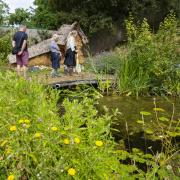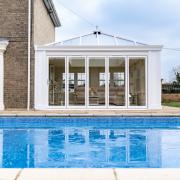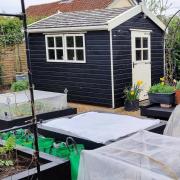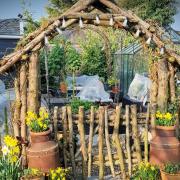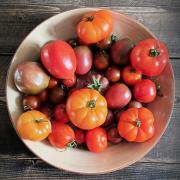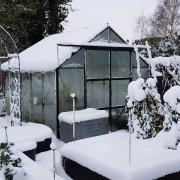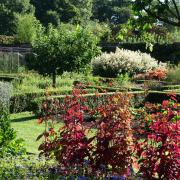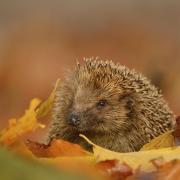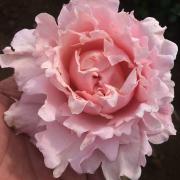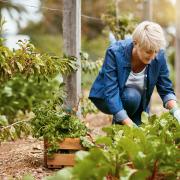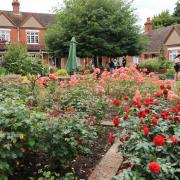Wouldn’t you like one of these quirky animal sculptures to live in your garden? Suffolk artist Liz Cooke can make one for you.

Shapely evergreens or vividly coloured stems help to lift the garden on a bleak and soggy January day but what you really need is a touch of humour and personality to lift the spirits. And would you believe it? I’ve found it right here in West Suffolk.
Sculptor Elizabeth Cooke is in a heron phase and, to be honest, her all-season steel birds are so charming I would quite like to invite them indoors for a saucer of milk by the fire. These delightful creatures – ducks and dragonflies among them – have a real quality of movement and feeling. No doubt this comes from the fact that Liz trained, not as an artist, but as a contemporary dancer at the acclaimed Trinity Laban Conservatoire of Music and Dance in London. She’s also happy to be called Liz, by the way. And the herons?
“Part of my obsession with the herons in the past year is that my father died with Alzheimer’s a year ago,” Liz explains. “When we were young we went to Minsmere and did loads of birdwatching, so I kind of feel close to him because I’m doing all these bird things.”
She has also immersed herself in researching these magnificent birds and, on the wall of her clean, non-sculpture studio (she also has a dirty one where mucky stuff like soldering takes place) she has displayed three of her own paintings of herons. One is after Thomas Bewick, her original source of inspiration, another after Audubon, and a third inspired by a wonderful book of Egyptian art belonging to her mother, also an artist.

“Fabulous book,” says Liz, opening it up in front of me. “All these colours. It’s just so inspirational.” Eventually, after her self-confessed obsession with herons, she thought she’d done so many herons she really must do something else. “Then I thought, well, I haven’t really finished with the whole Egyptian theme and I just loved it so much, so then I did the goose, the Ibis and the duck. I also did an owl.”
Making the switch from contemporary dance to sculpture doesn’t sound like an obvious move especially after gaining a masters, but Liz explains: “While I was working, I was doing evening classes with a friend and it was her turn to choose a subject. She chose sculpture and I didn’t really want to go to that but it was her choice so I had to go along.
“After the first lesson I was completely smitten. We did plaster casting and I absolutely loved it. I learned a bit of stone carving and metal work at evening classes then we eventually moved to Suffolk and I started doing it fulltime.”

Learn which plants will bring autumn colour to your garden
The move out of Lewisham was a homecoming for Liz, having been brought up in Ipswich, but for partner Mark Wharton, a Londoner, it was a case of persuading him to move further away from his home patch. At the time, Liz’s parents were in Framsden and brother Chris, a landscape gardener, was in Hengrave. Liz started working with Chris when someone asked him for a willow fence.
“I said I was willing to learn so then I went off on the willow tangent for a few years.” Enter the family-run Lark Valley Willow which included Liz’s willow sculptures, ranging from a quirky pair of tennis players to St Edmund’s Crown, for the Greene King roundabout in nearby Bury St Edmunds.

Liz is now focused on her steel sculptures but still does willow by commission. Lockdowns brought their own challenges, not only for willow, ”which would start to weather before I got to exhibit it,” but also for her steel work. On the one hand, she has been able to “hibernate” and get truly absorbed in her sculpture. On the other, exhibitions have been cancelled or postponed, such as Art for Cure at Glemham Hall, which went online, and Sculpture in the Valley by Waveney and Blyth Arts, postponed until this year 2021.
“It’s quite difficult as most of the sculpture stuff I do ends up outside whereas I really need to exhibit indoors,” says Liz. She coats her steel sculptures with yacht varnish which will eventually wear off. “So it’s up to the customer whether they want to re-varnish or they want it to go rusty.” She can’t quite decide which she prefers.
Inspiration comes mainly from nature, the Minsmere bird-watching in earlier days, and the more recent holidays in Scotland with Mark. “Just all the natural world I love.” Their children have flown the nest (so to speak) with William on a degree course in new Jersey and Millie a student at Laine Theatre Arts in Surrey. And Mark?
“I don’t know what he does,” Liz laughs, dropping in words like “technology” and “Machine to Machine”. “I get my friends to ask what he does so I can listen. But because of what I do, I can’t understand. He’s also normal as well. He plays the saxophone, keeps bees and takes photographs.”

As for Liz’s early dancing career, her immersion in a world of movement has indeed influenced her work. “I subconsciously feel a movement and flow about every subject,” she says. “I don’t try to create a realistic image but rather to capture the feeling, movements and appearance of a bird, animal or insect. A moment in time in their life.”
You may ask how you can possibly fall in love with something made of steel but once you look at Liz Cooke’s herons with their sweet, beady little eyes and raising their crests in greeting, believe me you can. As Liz herself posted in a tweet: “My two baby herons out in the world.”
Find out more at elizabethcookesculpture.wordpress.com




